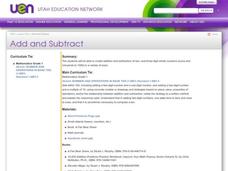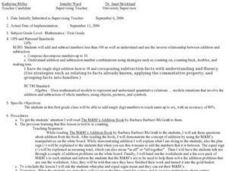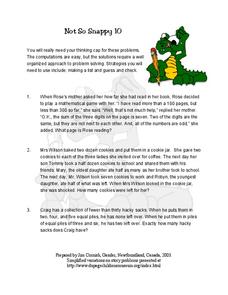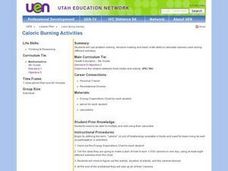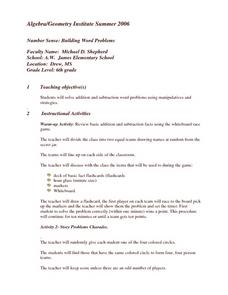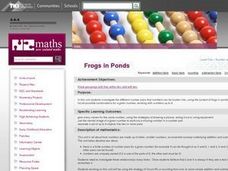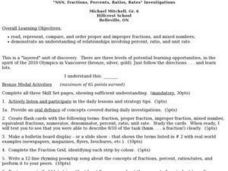Curated OER
Using 10 to Subtract
For this using ten to subtract worksheet, students, with a partner, problem solve and calculate together the answers to five subtraction word problems.
Curated OER
Division
Students use their knowledge of multiplication to learn problem solving strategies to solve division problems. In this division lesson plan, students play a circle game, work in small groups to review times tables, and solve division sums.
Curated OER
Add and Subtract
Like the cubs in A Fair Bear to Share, your 2nd grade class will practice adding and subtracting double-digit numbers by grouping, regrouping, and sorting a collection of objects. This requires many resources, but it is well worth the...
Learner
Solid Shapes
A collection of two lessons, kindergartners will identify two-dimensional shapes in solid shapes. They will develop basic knowledge of the components that make up a sphere, rectangular prism, pyramid, cylinder, cone, and cube. Young...
Curated OER
Make it Easier-- Add, then Take
In this math worksheet, learners learn a mental math strategy in addition called compensation. When adding a number such as 29, students learn to add 30, then take 1 away. Learners solve 25 problems in which they round to the nearest...
Curated OER
M & M Addition
Eat your math manipulatives, are you serious? Yup, Learners listen to the story The M & M's Addition book, add single digit numbers to reach sums up to six, and demonstrate addition and subtraction number combinations using several...
Curated OER
Introduction To Solving Equations
Use manipulatives (film cans and balance scales) to visualize and solve equivalent equations with your math class. After a lecture/demo, they utilize handouts and solve various equations using the methods learned.
Curated OER
Using Tens Frames for "Teen" Numbers
Sixth graders practice recognizing teen numbers for the part-whole strategy of bridging to ten. They approach the advanced counting stage to problem solve addition facts to ten utilizing dot patterns on a quinary frame with dot patterns...
EngageNY
The Division Algorithm—Converting Decimal Division into Whole Number Division Using Mental Math
Make math much simpler with mental math methods. The 16th installment in a series of 21 looks at ways scholars can apply mental math to convert division problems into easier problems with the same quotient. Multiplying or dividing both...
Illustrative Mathematics
Equal Area Triangles on the Same Base II
A deceptively simple question setup leads to a number of attack methods and a surprisingly sophisticated solution set in this open-ended problem. Young geometers of different strengths can go about defining the solutions graphically,...
Virginia Department of Education
Distance and Midpoint Formulas
Small groups work through two guided activities to derive the distance and midpoint formulas for the coordinate plane. The activities begin with concrete examples and move to abstract.
Curated OER
Prioritizing Time
Tenth graders examine and identify how to avoid time conflicts in their own personal time schedules. They participate in a role-play about a time schedule conflict, participate in a class discussion, develop a list of their four most...
Curated OER
Addition and Subtraction Facts to 20 - Manipulative
Here is a good instructional activity that will allow your student to practice their addition and subtraction facts to 20. They practice facts using fact cards and practice strategies such as doubles strategies, and count to 10 strategies.
Curated OER
Not So Snappy 10
In this math worksheet, students look for the answers to each word problem that is focused around the number 10. They use the basic skills of arithmetic.
Curated OER
Estimation
Students estimate the cost of individual items found on a typical grocery list. They participte in a teacher-led demonstration, solve word problems, and estimate the cost of ten items placed into their group's grocery basket.
Curated OER
Caloric Burning Activities
Fourth graders use problem solving, decision making and basic math skills to calculate calories used during different activities. They determine the relation between food intake and activity. Students also figure out the activity,...
Curated OER
Math Lesson Study Plan
Second graders find missing addends by solving math word problems. In this missing addend lesson, 2nd graders work in a whole group setting to find the missing addends in word problems before using the strategies to work independently....
Curated OER
Building Word Problems
Sixth graders study addition and subtraction facts. In equal groups, they play a race game to correctly solve addition and subtraction problems. Using a PowerPoint presentation, the teacher demonstrates how to write word problems and...
Curated OER
Frogs in Ponds
First graders determine how numbers are made up of other smaller numbers before examining addition and subtraction. They determine the number pairs that make up a given number and determine when no other pairs can be found. They use frog...
Curated OER
Partial Products
Students use the partial products algorithm to complete multiplication problems. In this partial products lesson plan, students are introduced to the algorithm and connect the relationship to multiplication and division problems.
Curated OER
Angry Feelings
Students explore how to manage angry feelings. In this behavior instructional activity, students discuss techniques to handle angry feelings, such as counting to ten and talking out the problem.
Curated OER
"NSN, Fractions, Percents, Ratios, Rates" Investigations
Sixth graders engage in an investigation about the concepts related to fractions. They read, represent, compare, and order proper and improper fractions, and mixed numbers. They demonstrate an understanding of relationships involving...
Curated OER
One- and Two-Digit Multiplication
Third graders multiply whole numbers by one- and two-digit numbers using base ten blocks and technology connection.
Curated OER
Number and Operations- Using Gift Certificates
Students apply number and operation skills to learn how to spend a gift certificate. In this mathematical reasoning lesson, students use base 10 blocks as money and calculate how much money they have.




